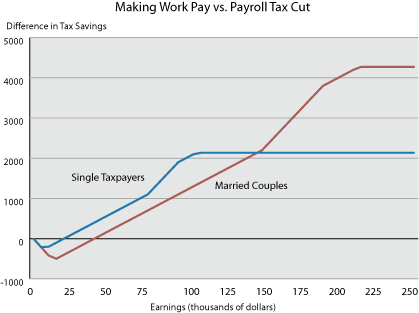As you may know, there is a temporary 2% payroll tax cut in 2011. Instead of the normal 6.2% Social Security tax on gross wages up $106,800 for employees, it is only 4.2%. This is supposed to be reflected automatically in your paycheck, so most people’s paychecks this year should have been a little bit bigger. I say most because at the same time, the Making Work Pay Tax Credit was expired for 2011. Here’s a chart from the Tax Policy Center showing the net savings from last year for your given income:

A single person earning $50,000 would be paying $600 less in taxes in 2011 vs. 2010. This is the net result of gaining the $1,000 payroll tax cut, and losing $400 from the Making Work Pay Tax Credit of 2009/2010.
The law was passed right around the start of the new year, so according to Consumer Reports so there could have been a mix of under-withholding and over-withholding for the first few pay cycles. Employers had until March 31st to get all the withholding sorted out. It’s pretty late in the year already, but still I just did a quick check to make sure that I am still getting that 2% savings. It just takes a minute – find your paycheck stub, and divide the Social Security line by your Gross Pay line. It should equal to 0.042, or 4.2%.
(Update: It could end up a bit less than 4.2% if you have items that are not subject to Social Security tax, like health insurance premiums or Flexible Spending Accounts. But it shouldn’t be more than 4.2%.)
You’ve been putting that extra money to good use, right?
 The Best Credit Card Bonus Offers – 2025
The Best Credit Card Bonus Offers – 2025 Big List of Free Stocks from Brokerage Apps
Big List of Free Stocks from Brokerage Apps Best Interest Rates on Cash - 2025
Best Interest Rates on Cash - 2025 Free Credit Scores x 3 + Free Credit Monitoring
Free Credit Scores x 3 + Free Credit Monitoring Best No Fee 0% APR Balance Transfer Offers
Best No Fee 0% APR Balance Transfer Offers Little-Known Cellular Data Plans That Can Save Big Money
Little-Known Cellular Data Plans That Can Save Big Money How To Haggle Your Cable or Direct TV Bill
How To Haggle Your Cable or Direct TV Bill Big List of Free Consumer Data Reports (Credit, Rent, Work)
Big List of Free Consumer Data Reports (Credit, Rent, Work)
So, if it doesn’t equal 4.2%…should I raise a stink? Doing the math (married, filing jointly), mine equals 3.35%. Or is your math only for a single filer?
0.041 here. Thanks for sharing! That was a fun exercise!
Last year our company announced no raises and a massive increase in our health care premium contributions, so sadly for us, that ‘extra’ was never even seen as it went right into keeping us insured.
All to the mortgage this year. I didn’t want to see the money and get used to it.
Interesting, I’m at 0.040. Same for both the latest paycheck and YTD, so the small difference isn’t due to different withholding earlier in the year.
Is there anything to be concerned about if it’s too low?
.034
Dan: I believe that Flexible Spending accounts and health insurance premiums aren’t subject to the social security withholdings. That could account for the difference.
Shannon: Thank you! That was it. It’s a perfect 0.042 when I subtract FSA and health items.
4.0% using SS and Gross. 4.17% when taking flex and medical premiums into account. Close enough!
@Shannon – Thanks for the tip! It would equal something less than 4.2 if you have deductions that aren’t subject to Social Security, but it definitely shouldn’t be higher.
But it really shouldn’t be around 6.2 unless your payroll is done by hand or something.
I took the extra 2% off the top above the budget items and funneled it to a separate savings line item. Primarily, I didn’t want to “get used to it”, but now I realize that I never made a plan for it. I guess I’ll just toss it in the Savings bucket at some point, though why I didn’t just do that to begin with, I don’t know.
Thanks for the info!! The way companies are handing out huge raises (lol). We all need to make every penny count.
Mine is the 4.2%
Medical, Dental and Vision plans not subject to SS tax apparently.
Illinois increased their income tax 66% (from 3% to 5%) so sadly we didn’t get any ‘savings’
Thanks for the post. Never too late to check. And this goes on for the next year too unless there is a new law passed. There will be no social security by the time most of the current workforce retires so we will be well advsied to save these extra bucks in a rainy day fund.